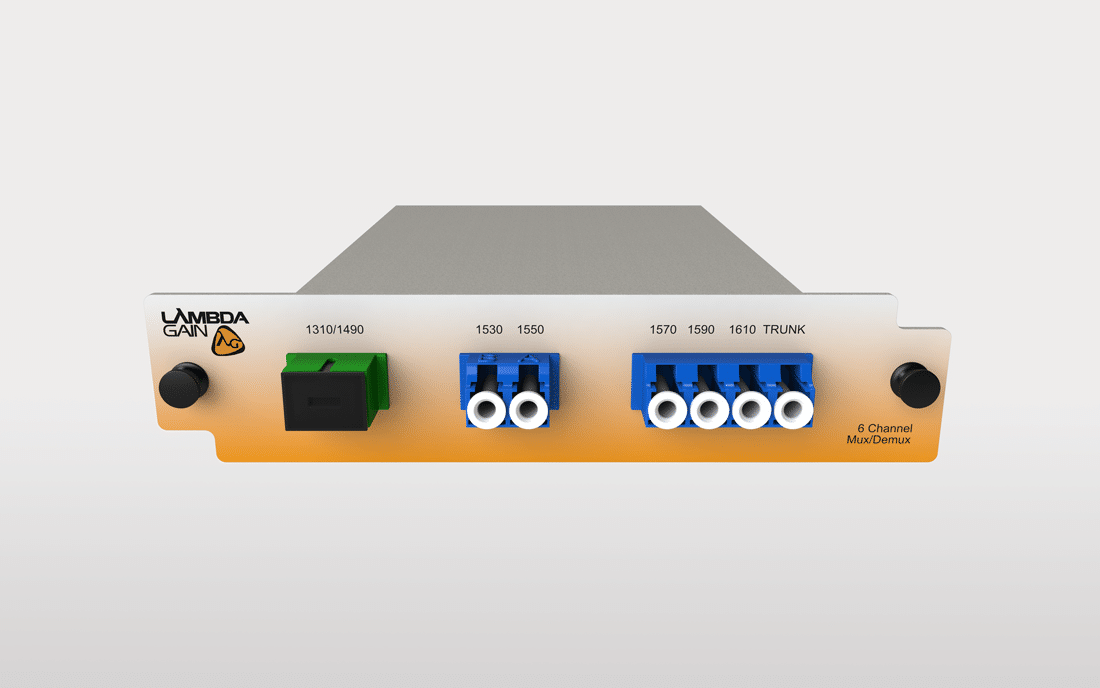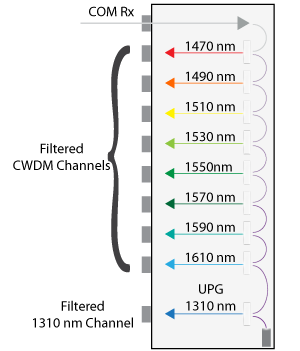
Building a Flexible WDM Network – Express and Upgrade Ports
Wavelength Division Multiplexing (WDM) is an increasingly common way to maximize the efficiency of fibre optic networks. This technology allows the combination of multiple signals in a single fibre strand and is a big win for the communication industry.
Passive WDM solutions are advantageous because of they:
- Are very easy to install and operate.
- Do not need any electricity to function.
- Are “protocol agnostic” and can be used on existing infrastructure.
- Very low latency.
- Can be used by simply plugging the appropriate fibre strand into its correspondent wavelength port.
We covered the basics of how WDM technology works in the Learning Center. However, some WDM filters go beyond the basic functions and offer additional functionality that can increase your network’s flexibility.
Express ports, for example, allow for a wide range of wavelengths to pass through a single port while Upgrade ports add individual wavelengths that are not commonly found in WDM filters.
These extra ports are extremely useful. Knowing how to properly use them can reduce your total cost of ownership, enhance your choices for upgrading your network, enhance reliability, compatibility, and capacity.
EXP vs UPG: Isolation Makes the Difference
Isolation is one of the most important concepts when implementing a passive WDM solution. It measures the capacity of a port to isolate desired wavelengths and reflect “unwanted” ones.

Figure 1: WDM 1550nm channel
Figure 1, illustrates how a high isolation lens can filter the 1550nm wavelength from a multiplexed signal and reflect the other frequencies back.
This shows an “ideal” situation. In reality, WDM filters never achieve 100% isolation.
High isolation lens in Upgrade ports can make the power of the passband 30dB to 45dB higher than that of any undesired wavelengths.
On the other hand, Express ports purposely have lower isolation values so that a wider range of wavelengths can pass through. This makes Express ports more flexible, but also more prone to noise from other wavelengths.
It is important to note the different isolation values of Express and Upgrade ports when deciding how to use them.
Use Case –Express Ports for Cascade Multiplex
Express ports are a perfect solution for situations that demand a cascade multiplex. Let’s look at the example of an 8 channel CWDM filter with a 1270-1450nm EXP port.

Figure 2: Lambda Gain 8 Channel CWDM with 1270-1450nm EXP port
Figure 2 shows the demultiplexing process of the filter. As the main signal travels through the module, the CWDM wavelengths are filtered one by one by high isolation filters.
Since the isolation operation is never perfect. A small residue of each channel is inevitably left in the main signal, creating noise as it travels through the module.
This noise has little effect on the channel ports. Their high isolation filters reduce the undesired wavelengths going through.
Due to the lower isolation of the Express port, it is not as effective as the WDM port in filtering out the “undesirable” wavelengths.
When analyzing the resulting signal of the EXP port, note that there is only a 14dB difference in power between the passband (1270-1450nm) and undesired wavelengths.
This means that the signal resulting from the filtration of the EXP port carries significant noise from other channels.
Because of this noise, EXP ports should not be used for direct connection to transceivers. Their poorly isolated signal can cause bad Bit to Error rates (BER).

Figure 3: Isolation chart of EXP port
Since Express ports allow for a large range of wavelengths to pass, they are perfect for Cascade Multiplex solutions.
A second WDM module attached to the Express port could isolate any number of channels ranging from 1270 to 1450 nm. In the upstream, the Express port allows the multiplexing of these channels in the same wire as the CWDM channels.
This solution allows a network operator to escalate the number of wavelengths per wire, greatly increasing fibre efficiency.

Figure 4: Cascade Multiplex
Use Case – High Isolation UPG Channels for Direct Connection
Upgrade ports are designed to isolate specific wavelengths that are not usually available in WDM filters.

Figure 5: LambdaGain 5 Channel CWDM with UPG 1310 & 1490 nm
They can let only a single wavelength pass, but their high isolation value allows for a direct connection between the Mux/Demux and a transceiver.
In Figure 4 we can see the same 8 Channel WDM module, but this time with a 1310nm UPG port.
The UPG channel isolates the 1310nm wavelength and reflects any noise and undesired wavelengths left in the signal.
Upgrade ports are designed to add extra wavelengths to your WDM solution. They are very useful for incorporating legacy equipment into your WDM network.
Here’s a comparison of the difference between Express and Upgrade ports.

Figure 6: Express vs Upgrade
Conclusion
Express and Upgrade ports add great flexibility to your network, but an operator must know which scenario is best for each solution.
